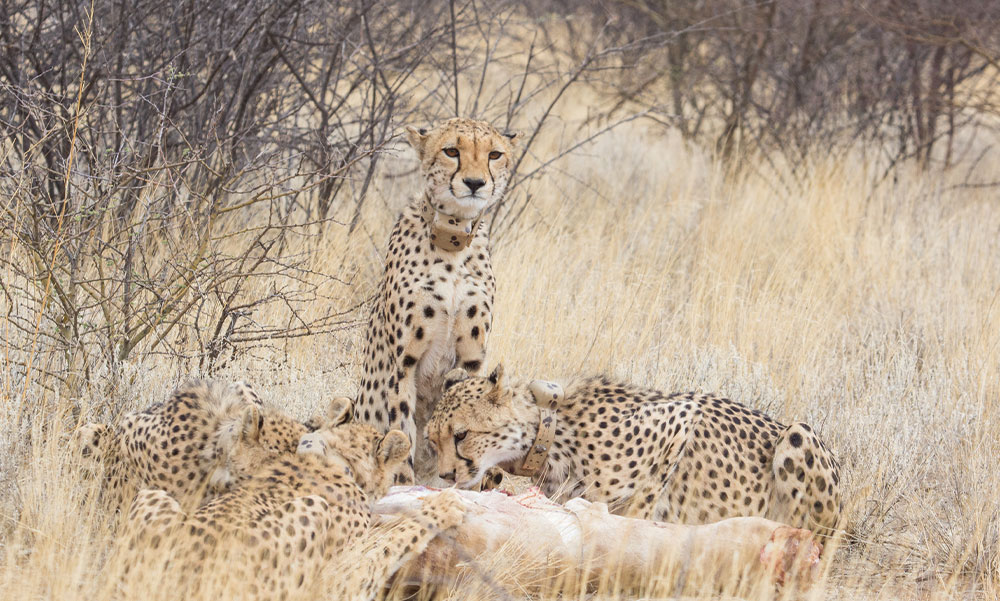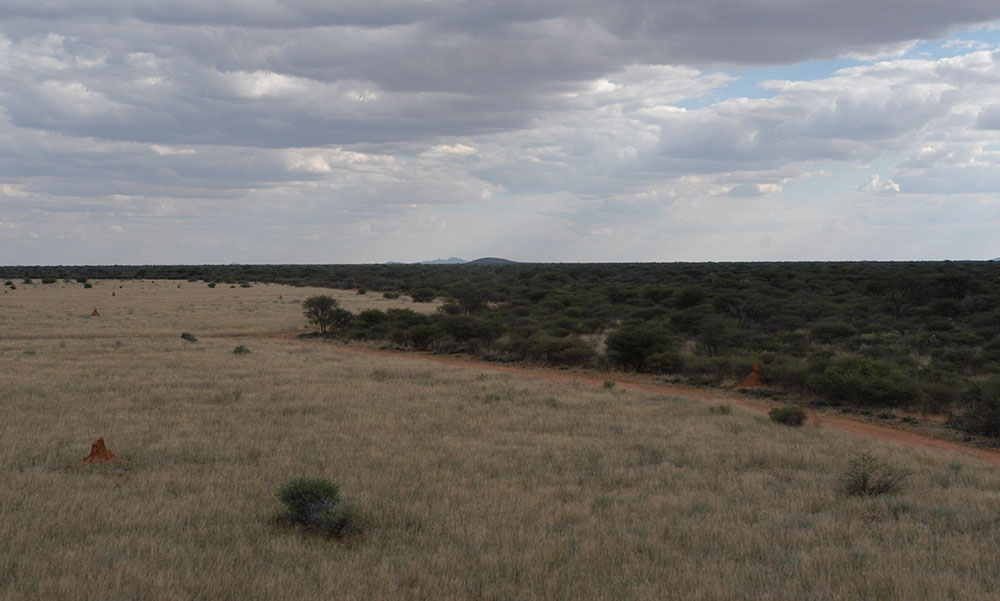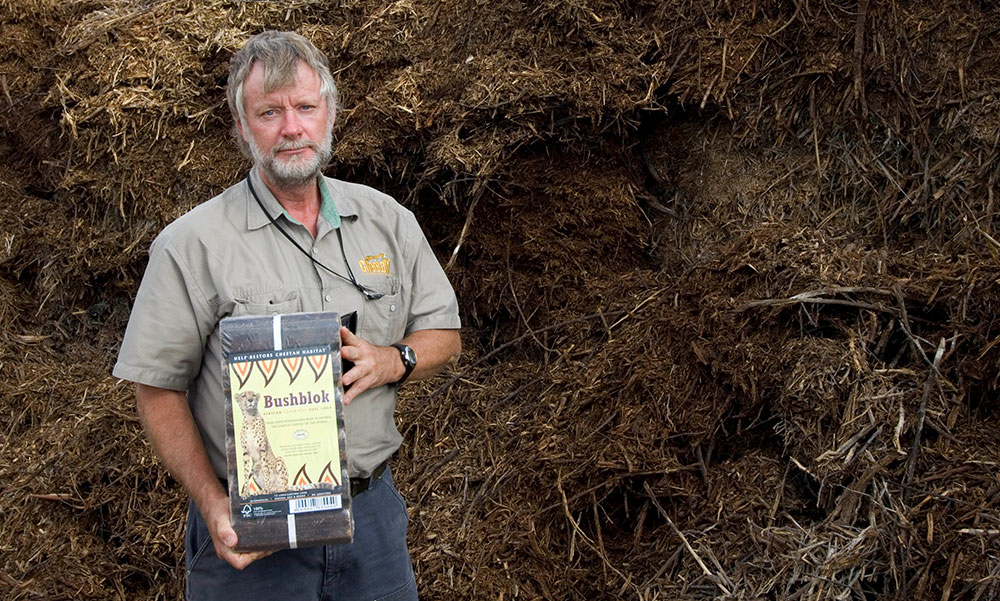In Somaliland, il florido mercato nero sottrae trecento ghepardi l’anno alla natura.
Pubblicato: 30 novembre 2021 Archiviato in: Cheetah Conservation Fund Commenti disabilitati su In Somaliland, il florido mercato nero sottrae trecento ghepardi l’anno alla natura.Tiny, weeks-old cheetah cubs suckled from baby bottles and purred weakly, their condition still dangerously precarious after their rescue from the Horn of Africa’s illegal wildlife trade.
Around half the cubs saved from traffickers do not survive the trauma — and there are real concerns for the smallest of this lot, a frail infant nicknamed “Green” weighing just 700 grams (25 ounces). (Nel frattempo Green si è ripresa e sta benissimo)

Fighting the criminal trade in cheetah cubs is particularly challenging because it revolves around Somaliland, a self-declared republic without international recognition, and one of the world’s poorest regions Photo: AFP / EDUARDO SOTERASnull
“It was very touch and go with Green,” said Laurie Marker, founder of the Cheetah Conservation Fund (CCF), inspecting the mewling cub at the non-profit organisation’s rescue centre in Somaliland.
They are the lucky ones — every year an estimated 300 cheetah cubs are trafficked through Somaliland to wealthy buyers in the Middle East seeking exotic pets.
Snatched from their mothers, shipped out of Africa to war-torn Yemen and onward to the Gulf, cubs that survive the ordeal can fetch up to $15,000 on the black market.

It is a busy trade, one less familiar than criminal markets for elephant ivory or rhino horn, but equally devastating for Africa’s most endangered big cat.

Cheetah have been sought after as exotic pets for centuries but today demand for cubs is placing enormous strain on the vulnerable species Photo: AFP / EDUARDO SOTERAS
A century ago, there were an estimated 100,000 cheetahs worldwide. Today barely 7,000 remain, their numbers slashed by human encroachment and habitat destruction.
The steady plunder of cubs from the wild to satisfy the pet trade only compounds this decline.

The number of cheetahs sheltered at safe houses run by the Cheetah Conservation Fund in Somaliland has soared as the government has cracked down on the illegal cub trade Photo: AFP / EDUARDO SOTERAS
More than 3,600 live cheetahs were illegally traded worldwide in the decade to December 2019, according to research published this year that documented hundreds of advertisements for cubs on social media platforms including YouTube and Instagram.null
“If this keeps going… that kind of offtake causes the population to go extinct in a very short time,” said Marker, a leading authority on cheetahs.
Cheetahs have been prized as pets and hunting companions since the Roman Empire and breeding them in captivity is notoriously difficult, making wild-caught cubs the only option.

Snatched from their mothers, shipped out of Africa to war-torn Yemen and onward to the Gulf, a cheetah cub that survives the ordeal can fetch up to $15,000 on the black market Photo: AFP / EDUARDO SOTERAS
Part of the campaign to stop the modern-day trade has focused on changing attitudes in prosperous Gulf states, the main buyer market where cheetahs are still coveted status symbols.https://0136535c4c9d4a82ce259db274cc612a.safeframe.googlesyndication.com/safeframe/1-0-38/html/container.html
Marker said wealthy owners liked to show off their cheetahs in selfies as much as their cars and cash.
“There’s kind of a one-upmanship on it, and there’s bragging power. One of our messages is do not ‘like’ this kind of thing on social media,” Marker said.

Somaliland is expanding intelligence sharing with neighbouring countries and Yemen to better tackle the illegal trade Photo: AFP / EDUARDO SOTERAS
Combatting this criminal trade is particularly challenging because it revolves around Somaliland, a self-declared republic without international recognition, and one of the world’s poorest regions.

Every year an estimated 300 cheetah cubs are trafficked through Somaliland to wealthy buyers in the Middle East seeking exotic pets Photo: AFP / EDUARDO SOTERAS
Roughly the size of Syria, with 850 kilometres (530 miles) of coastline facing Yemen, the breakaway region between Ethiopia, Djibouti and Somalia is stretched thin policing its porous borders.
Somaliland’s interior minister Mohamed Kahin Ahmed told AFP that a small coastguard unit was doing its best but apart from patrolling for cheetahs they had human traffickers and gun runners to contend with.
The cubs that slip through the net suffer terrible mistreatment along the smuggling route, fed improperly and confined to tiny cages, sometimes with their legs bound with zip ties.
Marker said one particular seizure in 2019 illustrated the cruelty: “When they dumped them out, there were live ones dying on top of dead ones… It was just horrible,” she said.
In recent years, confiscations have soared as the government has cracked down on the trade.
From just a handful of cubs in 2018, today CCF shelters 67 rescued cheetahs across three safe houses in the Somaliland capital Hargeisa.
Laws criminalising the sale of cheetahs have also started being enforced.
In October 2020, a smuggling ring was shattered and a high-profile trafficker prosecuted in a landmark trial.
Through a UK government-funded programme, Somaliland is expanding intelligence sharing with neighbouring countries and Yemen to fight the criminals robbing Africa of the iconic species.
But the government is also working with impoverished rural communities, whose conflict with cheetahs is another driver in the trade.
Of the 13 cubs confiscated between September and November, at least four were taken by farmers hoping to sell them and recoup losses after claiming their livestock were killed by cheetahs.
“The next generation may never see a cheetah if this illicit trade continues,” Edna Adan Ismail, Somaliland’s former foreign minister, told an anti-poaching conference in September.
Local veterinarian Ahmed Yusuuf Ibrahim is determined this grim prophecy does not pass.
The 27-year-old has been learning how to nurse sickly cubs back to health and has developed a close fondness for the cheetahs under his care.
They cannot fend for themselves, and eventually will be relocated to a larger natural enclosure outside Hargeisa.
But for now, Ibrahim is their doting custodian — right down to making sure cheetahs young and old get their fair share of camel meat.
“I care for them. I feed them, I clean them. They are my babies,” he said.
Copyright AFP. All rights reserved.PROMOTED CONTENT


La prima corsa di Khaleesi!
Pubblicato: 24 novembre 2021 Archiviato in: Cheetah Conservation Fund | Tags: Africa, cheetah, Cheetah Conservation Fund, conservation, dr.LAURIE MARKER, ghepardo, Namibia Commenti disabilitati su La prima corsa di Khaleesi!Dalla Namibia, ecco la più giovane dei ghepardi salvati recentemente, Khaleesi, che fa la sua prima corsa!
Seguita dai guardiani e dalla Dr Marker, dimostra già doti notevoli!
Khaleesi ha solo 8 mesi!
Video dal Somaliland! Altri cuccioli confiscati!
Pubblicato: 15 novembre 2021 Archiviato in: Cheetah Conservation Fund | Tags: Africa, cheetah, Cheetah Conservation Fund, conservation, dr.LAURIE MARKER, Hargeisa, Safe House, Somaliland Commenti disabilitati su Video dal Somaliland! Altri cuccioli confiscati!Ogni anno, circa 300 cuccioli di ghepardo vengono cacciati per trafugarli verso la Penisola Arabica.
La Dr. Marker è ritornata ad Hargeisa per monitorare la situazione dei cuccioli a rischio… guardate il video:
Cambiamenti climatici e ghepardi
Pubblicato: 5 novembre 2021 Archiviato in: Cheetah Conservation Fund | Tags: Africa, cheetah, Cheetah Conservation Fund, conservation, dr.LAURIE MARKER, ghepardo, Namibia Commenti disabilitati su Cambiamenti climatici e ghepardiDr. Laurie Marker

- della dottoressa Laurie Marker5 novembre 2021

Ghepardo selvatico su un albero da gioco. Foto di Craig Taylor
Unico tra i grandi felini: il ghepardo è l’animale terrestre più veloce, il più piccolo e il più antico delle specie di grandi felini e l’unico grande felino che fa le fusa. È anche il felino più a rischio d’estinzione in Africa.
Le tre maggiori minacce sono: la perdita dell’habitat, il conflitto con l’uomo per la predazione del bestiame e il traffico illegale di animali vivi per soddisfare la domanda di animali esotici. Tutte e tre queste minacce sono esacerbate dagli effetti del cambiamento climatico.
Ci sono meno di 7.500 ghepardi in tutti i suoi arealin in Africa, con una popolazione estremamente ridotta (meno di 50) di ghepardi in Iran. I ghepardi si trovavano in gran parte dell’Africa e dell’Asia e il loro rapido declino si è verificato negli ultimi cento anni. Abbiamo perso circa il 90% della popolazione di ghepardi durante quel periodo e il ghepardo si è estinto in 20 paesi negli ultimi 50 anni. In Namibia, abbiamo la più grande popolazione di ghepardi di circa 1.500 esemplari. Con l’aiuto di sostenitori dedicati in tutto il mondo, abbiamo stabilizzato la popolazione di ghepardi in Namibia.

Il cambiamento climatico rappresenta una minaccia significativa per tutta la fauna selvatica, perché accelera il cambiamento ambientale e esercita una pressione crescente su persone e animali che dipendono dalla terra per vivere. I ghepardi sono particolarmente vulnerabili ai rapidi cambiamenti ecologici e ambientali, in parte perché mancano di diversità genetica e sono cacciatori specializzati. Richiedono ampi spazi e terreni aperti per catturare le loro prede. Se non si interviene per affrontare le cause profonde del cambiamento climatico, ci troveremo di fronte a una rapida estinzione su vasta scala di molte specie.
Dipendiamo dai partecipanti alla #COP26 perché mantengano il loro impegno nei riguardi dei loro cittadini.
Il cambiamento climatico è un problema globale e gli sforzi per invertire la tendenza richiedono il sostegno dei più alti livelli di governo.
Al CCF, una delle tante cose che studiamo è l’ecologia del paesaggio arido che il ghepardo chiama casa. Abbiamo visto gli impatti della cattiva gestione del territorio e delle pratiche agricole non sostenibili nella savana. Abbiamo scoperto che nel tempo, il degrado dell’ecosistema si aggrava in modo esponenziale se non interviene l’essere umano in modo risolutivo.
Ad esempio, in Namibia, la vegetazione a livello del suolo (erba) è consumata più frequentemente da bestiame e ungulati selvatici (mammiferi ungulati), ma il livello medio della vegetazione (arbusto) è meno frequentemente consumato. Ciò è in gran parte dovuto all’assenza di megafauna (rinoceronti ed elefanti) che storicamente se ne cibano. La diffusa riduzione di queste specie di megafauna nell’ecosistema ha causato una invasione incontrollata di cespugli spinosi autoctoni. Man mano che il cespuglio spinoso cresce, le praterie aperte diventano gradualmente più fitte ed impenetrabili. Ciò riduce lo spazio disponibile per gli agricoltori per pascolare il loro bestiame, il che provoca un pascolo eccessivo. Man mano che più bestiame si nutre su un territorio ridotto, si crea un circolo vizioso di ulteriore perdita di habitat. Di conseguenza, le praterie aride in Namibia sono state ridotte a un’area delle dimensioni della California.


Abbiamo visto che la trasformazione delle praterie in cespugli non è esclusiva della Namibia, sta avvenendo in tutta l’Africa, causando il degrado del suolo nel tempo. I cespugli spinosi hanno radici molto profonde e attingono alla falda freatica crescendo costantemente ; combinato con una riduzione delle precipitazioni annuali, questo porta a problemi importanti come la desertificazione. Il passaggio dalle praterie alla boscaglia e il suo aumento del consumo di acqua ha un impatto negativo sull’economia della Namibia con una spesa di oltre 150 milioni di dollari americani all’anno in interventi per portare acqua alla popolazione.
Al fine di mitigare la perdita dell’habitat e ridurre la vegetazione arbustiva, il CCF lavora per disboscare i cespugli invasivi. Abbiamo trovato un modo per utilizzare il materiale di scarto legnoso per creare combustibile da biomassa. Bushblok®* è un tronchetto di combustibile ecologico che brucia in modo pulito ed è un’alternativa migliore per il riscaldamento e la cottura rispetto al carbone. La produzione di energia da biomassa con combustibili green come Bushblok® ha il potenziale di alimentare gran parte della nostra Namibia se viene ampliata.
L’habitat ripulito crea spazio per la fauna selvatica che può nuovamente attraversare i territori. Mentre recuperiamo la terra mediante bonifica, il team di ecologia di CCF ricerca gli effetti a breve e lungo termine sulla distribuzione di animali e piante e monitora i cambiamenti chimici nella struttura del suolo utilizzando diverse metodologie. La ricerca che conduciamo aiuta a capire meglio quali azioni di conservazione sono più efficaci nel ripristinare l’habitat.


Un’altra conseguenza della riduzione delle praterie è il declino delle prede selvatiche. Man mano che la popolazione umana cresce, le persone vivono in prossimità di specie predatrici come il ghepardo e, sfortunatamente, questi due fattori si traducono in maggiori episodi di conflitti uomo-fauna selvatica. Al fine di mitigare il conflitto uomo-fauna selvatica, il CCF ha sviluppato una serie di programmi di educazione degli agricoltori che promuovono le tecniche di allevamento rispettose dei predatori. La nostra formazione “Future Farmers of Africa” insegna buone pratiche di gestione del bestiame, dei pascoli e della fauna selvatica, incluso l’uso di cani da guardia del bestiame (LGD). Proteggendo il bestiame degli agricoltori dalla predazione con una presenza imponente e un abbaio molto rumoroso, i cani da guardianìa aiutano a ridurre le perdite di bestiame dall’80 al 100%, riducendo così la necessità degli agricoltori di uccidere ghepardi e altri predatori.
La ricerca del CCF, e la ricerca di molti altri, hanno dimostrato che abbiamo ancora tempo per fare la differenza verso l’arresto della progressione del cambiamento climatico. I sostenitori del CCF fanno l’investimento ogni giorno finanziando il nostro lavoro su tutti gli areali dei ghepardi. Insieme stiamo invertendo la perdita di habitat, prevenendo un ulteriore degrado del suolo, rafforzando lo sviluppo dei mezzi di sussistenza e incoraggiando l’agricoltura sostenibile. Siamo ancora in tempo per salvare il ghepardo. In questo modo, beneficeremo di tutto ciò che ruota intorno all’habitat del ghepardo.
Il cambiamento climatico è un grosso problema e abbiamo bisogno del sostegno di governi e leader aziendali in grado di offrire un aiuto su larga scala. Abbiamo tempo e i giovani del mondo dipendono da noi. Non possiamo semplicemente sentirci impotenti riguardo a questa situazione. Invece, dobbiamo lavorare insieme e cambiare il mondo in #SaveTheCheetah.
*Bushblok® è certificato Forest Stewardship Council – FSC® (FSC-C004580).
